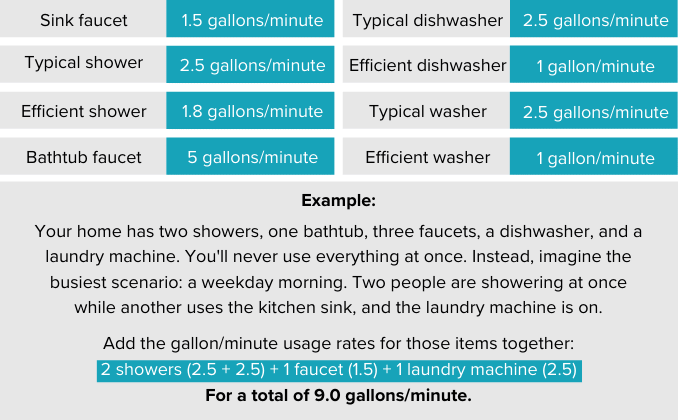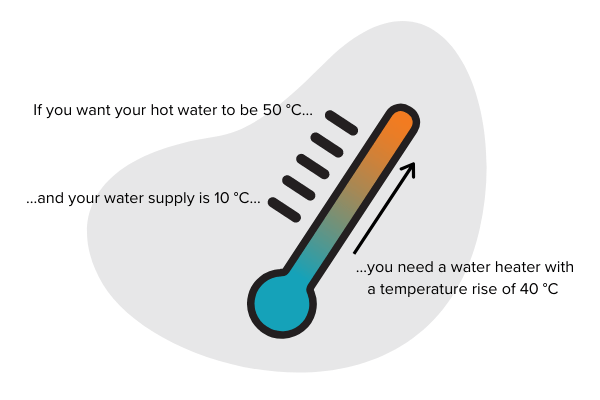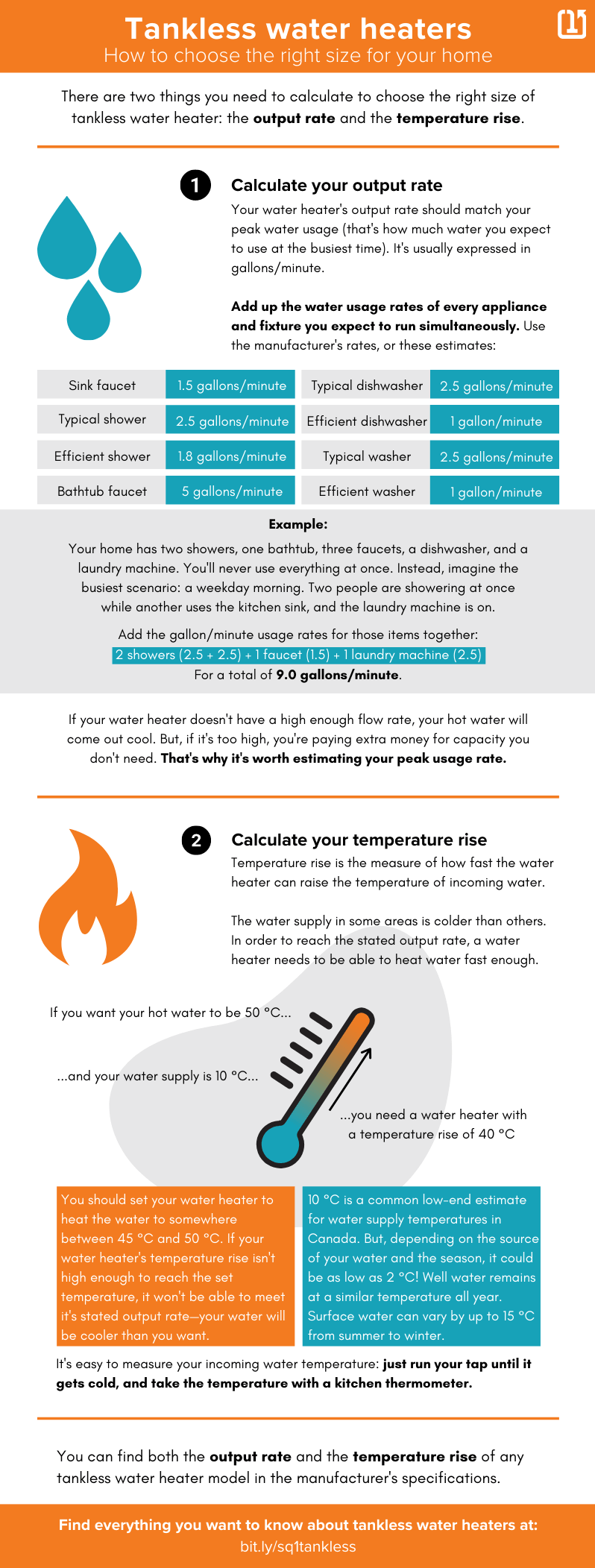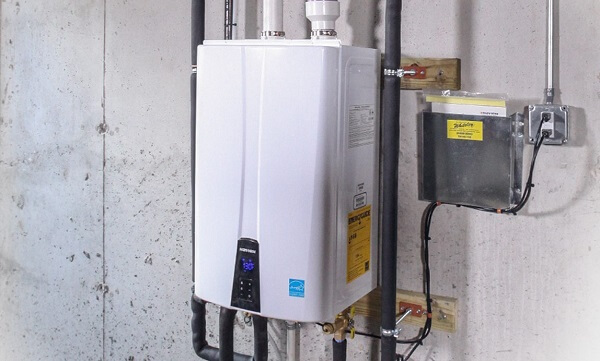What size tankless water heater do I need?
By now, you should have a good idea of whether or not a tankless water heater is right for you. But if you’ve decided to install one in your home, how do you choose the right one?
First, you need to decide if you want an electric or a gas model, based on the information above.
Then, you basically need just two pieces of information to make sure you’ve chosen the right tankless water heater for your home: the output rate and the temperature rise.
Here’s how to figure out both:
(Jump to the bottom of the page if you’d prefer a visual guide!)
Output rate
Tankless water heaters can’t produce an unlimited amount of hot water; if you use too much at once, your heater won’t be able to keep up, and your water will be cooler than you want.
The maximum output of a hot water heater is measured in gallons or litres per minute.
To figure out how much you need, calculate your peak hot water usage. That is, how much hot water do you expect to need at the busiest time?
Figure out which hot water appliances or outlets you’ll be using at that time and add their usage rates together. You can often find an appliances usage rate in the manual, or on the manufacturer’s website. If you can’t find the specific usage rate, an estimate is close enough.
Here are some estimated usage rates for common appliances and fixtures, and how to use them in calculating your peak usage rate:

Of course, you want a water heater that will keep up to your demands. But, getting one that’s too large is a waste of money and energy. That’s why it’s worth calculating your home’s peak hot water usage.
Temperature rise
The other important stat you want to look at is the heater’s temperature rise. This is the measure of how quickly it can heat water—slightly different than how much it can output.
Temperature rise matters because the incoming water temperature varies from place to place and season to season. A water heater that functions perfectly during the summer may struggle during the winter, as the water supply is colder. The output rate above assumes that your heater also has a high enough temperature rise; if the rise isn’t high enough, its output rate will drop.
To figure out your required temperature rise, start with an estimate of your incoming water temperature—use the lowest winter temperature you expect to commonly deal with. 10 °C is a common benchmark, but the water supply in colder parts of Canada can drop as low as 2 °C!
Then, decide how hot you want your water to be. You typically want to raise it to somewhere between 45 and 50 °C. With a tankless water heater, you don’t need to worry about killing bacteria like in a hot water tank, so set the temperature no higher than what you actually intend to use.

The difference between your incoming water temperature and your desired temperature is how much temperature rise you need on your tankless water heater.
What should you do when something goes wrong?
Here are some common issues with tankless hot water heaters and tips to resolve them:
Have no hot water
Check to make sure the unit has power and is running.
On electric units, there should be a red standby light. If it’s not on, a breaker may have tripped. Reset the breaker. If it’s still not working, call a qualified technician.
If you have a gas-powered unit that’s not producing hot water, check the obvious stuff first: the gas valve is on, and you’ve paid your gas bill (or filled your propane tank).
If that doesn’t solve the issue, check your water heater’s exhaust vents. Obstructed vents can cause the unit to malfunction, too.
If the easy stuff doesn’t fix your unit, the problem may be more technical in nature and you’ll need to call an expert.
Not as much hot water as before
If your tankless water heater usually works fine but suddenly the water is cooler than normal, it could simply be that the water supply temperature has dropped. If the incoming water is extremely cold, the heater may not be able to warm it quite as much as in the summer.
There isn’t much you can do in that case except wait for warmer temperatures or buy a new tankless system with a higher water rise rating. If the issue is persistent, you could buy point-of-use heaters for the most important water outlets as a cheaper option.
When I turn the tap down to get just a light flow of hot water, it turns cold
Most tankless water heaters require a minimum water flow for the heater to come on—usually around 1.5 litres per minute (or 0.4 gallons). If the flow is less than that, the heater shuts off. To fix this, just open your tap a bit more to increase the hot water flow.
Can’t get enough hot water to fill my tub
If you open the hot water tap all the way, you may be pulling too much water for the heater to handle. Instead, turn the hot water down a little. It’ll take a little longer to fill the bathtub, but the water will be nice and hot.
Problems from improper installation
Sometimes problems stem from improper installation of your water heater:
Venting the exhaust
Tankless systems generate a lot of heat. Accordingly, the exhaust is very hot and needs to be vented quickly. The system monitors the exhaust temperature and will shut down if it can’t vent the heat and exhaust effectively.
A ventilation system with too many corners or too great a distance might cause your unit to overheat and shut down.
Scale buildup
If you have hard water in your area, minerals can build up in the heat exchanger. This can result in improper operation or even failure of the unit. See the next section on how to descale your heater. You can install a scale filter or a water softener to help prevent the buildup in the future.
High water pressure
If you live in an area with high water pressure, it could be putting stress on your tankless water heater (not to mention all your other plumbing). You may need to install a water pressure regulator to avoid premature failure of your water heater.
Incorrect size
Installing the wrong size tankless water heater is a common problem. Make sure you do the necessary research to ensure you have enough gas, you know how much output you require, and you place the heater in the right location. Otherwise, you may not have hot water when you need it.
A qualified professional contractor can help you determine the right size and the right location for your tankless water heater.
How can you maintain your tankless water heater?
One of the best things about tankless water heaters is that they’re pretty low maintenance. That being said, there are a few things you can do to help your water heater function smoothly:
Descaling
When you have hard water—that is, water with lots of dissolved minerals in it—it will cause a buildup of those minerals inside your water heater over time.
“One of the most common reasons tankless water requires maintenance is because of the buildup from hard water,” says Wiseman.
Scale buildup inside your water heater makes it function less efficiently, so you should descale it.
But, how do you descale your tankless water heater?
Flushing the system
You can dissolve the scale buildup by flushing your tankless water heater with a descaling solution—that is, disconnecting the water flow and pumping the solution through the unit instead.
“You may use vinegar flush or water softener to keep it from clogging the unit,” says Wiseman. “However, to do an effective job at this, I would recommend contacting an expert who can do the task quickly and effectively.”
So, it’s possible to flush the water heater yourself, but it’s best done by a professional.
If you want to see how a qualified technician does it, here is a video example.
Install a water softener
If you do have hard water, one solution to install a water softener to help prevent a buildup of calcium. Calcium is one of the minerals most responsible for scale buildup.
It is possible to DIY a water softener installation if you’re familiar with plumbing work, but it isn’t necessarily easy. You don’t always want all of your water running through the softener. For example, homeowners typically prefer un-softened water for outdoor use and drinking.
In those cases, you’d need to create new branches of your plumbing system to work around the water softener—a task best left to a plumber.
Cleaning the water filter
Tankless water heaters have sediment filters inside them. These filters aren’t fine enough to filter out the dissolved minerals that cause scaling, but they keep bits and pieces of other stuff from clogging your unit.
The filter is normally located at the cold water inlet.
You should take out the filter and give it a wash about once per year. To clean the filter, first shut off the cold water supply. Then, unscrew the filter, clean out the sediment, and replace it before turning the water supply back on.
What is the life expectancy?
Because there is no storage tank, and less risk of corrosion, the life expectancy of a tankless water heater is much greater than that of a regular hot water tank.
“The life expectancy of a tankless water heater system is generally 20 years if maintained and cared for very well,” says Wiseman.
That includes occasionally descaling your water heater if you’ve got hard water running through it.
What will your home insurance provider want to know?
Type of water heater
Before to buy home insurance, the insurance providers will want to know the type of water heater you have as well as the age. They may also want to know if it was professionally installed, or if there are any signs of leakage or rust.
The age
Water damage is the cause of many home insurance claims, so insurance providers are understandably concerned about older water heaters.
With the storage tank type, there is always the risk of leaking, or even rupturing, causing significant water damage. With a tankless model, there is much less chance of water damage occurring. But of course, even tankless models have a risk of some leakage (especially once they pass their life expectancy).
Other information
When you’re shopping for home insurance, be sure you know the type, age, and condition of your water heating system. This will help you get a speedy and accurate quote, as rates may vary based on these factors.
Discounts
Some home insurance providers offer discounts to customers who have tankless water heaters. After all, the fact that there’s no tank of water means one less source of potential water claims.
At Square One, we offer lower premiums to homes that have a new hot water heater. Check out some of the other discounts we offer.
Commonly asked questions
Does a tankless water heater increase home value?
Tankless water heaters don’t generally increase home value directly.
They are, however, a potential selling point. Many buyers see tankless systems as more modern than tank versions.
So, while you may not recoup the cost of installing a tankless system when you sell your house, it might make it easier to sell—and you’ll save on energy costs in the meantime.
Are tankless water heaters loud?
Tankless water heaters are normally not very noisy.
Of course, it depends somewhat on the model you have; some are louder than others. Most homeowners with tankless systems report that they can’t hear their units at all when they’re located in the garage or basement.
Most likely, the device that’s drawing hot water (a dishwasher, shower, or faucet) is going to make more noise than the water heater.
Visual guide: how to choose the right size tankless water heater

Want to learn more? Visit our Getting to Know Your Home resource centre for the complete rundown on all your home's systems and features. Or, get an online quote in under 5 minutes and find out how affordable personalized home insurance can be.







